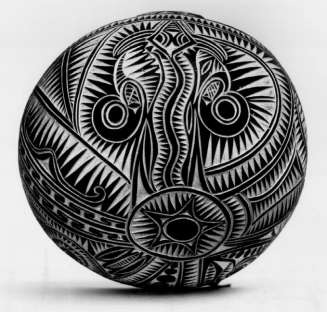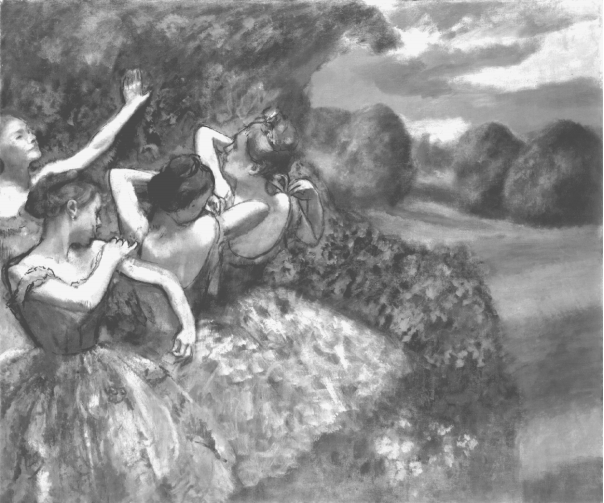Study Guide
Field 002: Art
Sample Selected-Response Questions
Recommendation for individuals using a screenreader: please set your punctuation settings to "most."
General Test Directions
This test consists of two sections: 1) a section with selected-response questions and 2) a constructed-response section.
Each question in the first section is a selected-response question with four answer choices. Read each question and answer choice carefully and choose the start uppercase ONE end uppercase best answer.
Try to answer all questions. Even if you are unsure of an answer, it is better to guess than not to answer a question at all. You will start uppercase NOT end uppercase be penalized for guessing.
The second section of this test consists of one constructed-response assignment. You will be asked to provide a written response to the assignment. Directions for completing your written response to the constructed-response assignment appear immediately before the assignment.
You may start uppercase NOT end uppercase use any type of calculator or reference materials during the test session.
Sample Selected-Response Questions
Competency 0001
Apply knowledge of techniques, materials, and tools used in drawing and painting.
1. When making a negative space drawing, an artist generally attempts to:
- draw the shapes that surround objects rather than drawing the objects themselves.
- arrange the composition so that no areas of empty space remain in the finished drawing.
- create a drawing in which foreshortened objects seem to advance toward the front of the picture plane.
- design a composition in which objects appear flattened and space appears two dimensional.
correct response: a. when making a negative space drawing, the artist concentrates on drawing the shapes of the spaces around objects rather than the shapes of the objects themselves. this technique helps the artist to be freed from conventional ideas of what an object looks like and to gain a greater understanding of the actual form and proportions of the object.
Competency 0002
Apply knowledge of techniques, materials, and tools used in sculpture and ceramics.
2. In ceramics, a bat is commonly used for which of the following purposes?
- beating a piece of clay to remove air bubbles
- incising lines in clay for surface decoration
- mixing liquid slip to an even consistency
- supporting a clay pot that is being thrown on a wheel
correct response: d. a bat is a flat even surface that can be attached to a potter's wheel. the bat and pot may be removed together to avoid the misshaping that may result from cutting the pot from the wheel.
Competency 0003
Apply knowledge of techniques, materials, and tools used in printmaking and fiber
arts.
3. Photo emulsion is a substance used in which of the following printmaking processes?
- dry point
- serigraphy
- linoleum block
- monoprinting
correct response: b. photo emulsion, a light-sensitive coating substance, is commonly used in serigraphy to transfer a "positive" image to a screen of synthetic fabric.
Competency 0004
Apply knowledge of techniques, materials, and tools used in media arts.
4. The U S Occupational Safety & Health Administration (OSHA) makes which of the following safety recommendations regarding working at computer workstations?
- Support the lumbar region of the back with a rolled up towel or back support cushion.
- The top of the monitor should be slightly higher than eye level.
- Use a work chair that has a four-legged base.
- Elbows should be lower than the keyboard when using the keyboard.
correct response: a. the U S occupational safety & health administration (osha) is a federal agency whose purpose is to ensure safe and healthy working conditions for the population. osha suggests using a rolled up towel or removable back support cushion if a workstation chair does not have a lumbar support.
Competency 0005
Analyze the use of the elements of art in works of art.
5. In a painting, placing large blocks of complementary colors side by side would most likely create an impression of:
- strong visual tension.
- sharply distorted proportions.
- muddy, washed-out tones.
- a subtle blending of hues.
correct response: a. complementary colors, which are opposite each other on the color wheel, provide maximal visual contrast. the juxtaposition of these colors results in a vibrating sensation in the eye and thus an impression of tension.
Competency 0006
Analyze the use of the principles of design in works of art.
6. start bold Use the reproduction below of a carved coconut shell to answer the question that follows. end bold

the incised parts of the shell are white and the remaining surface is black. there is a star with a black circle inside and a circle surrounding it. a design resembling an undulating snake extends upward from the star's outer circle. reverse curve designs flank the snake in a winglike manner. the rest of the surface is covered with straight or curving bands delineated by black and white borders. nearly all of the areas between the borders of the shapes are closely filled with narrow triangular patterns that create a black and white saw-toothed texture.
Which of the following best describes the interaction of elements in this work of art?
- The variety of decorative shapes and lines gives the work a random, unplanned appearance.
- Unity is created by the use of curving elements that echo the natural shape of the coconut.
- The highly dramatic use of value contrasts tends to flatten the work visually.
- The rhythm of the design is interrupted by the repeated use of the pointed, toothlike motif.
correct response: b. the use of strong, sweeping curves and round motifs in the decoration of this object reiterates the coconut's natural curved form, helping to create an overall sense of unity.
Competency 0007
Apply knowledge of art of prehistoric and ancient periods (e.g., Greek, Roman, Egyptian,
Chinese).
7. start bold Use the reproduction below to answer the question that follows. end bold

the image is black and gray, presented in a long horizontal rectangle. it shows a misty landscape with what appears to be a body of water bounded by land. in the near left corner, there is a small portion of land with a few trees. across the left half of the image, about halfway up, is a distant shore with what could be a few low islands, beyond which are some jagged mountains that fade into the mist on the left and right. the right half of the image is dominated by a near jagged shoreline with scattered trees, rising steeply to a jagged mountain.
This painting is an example of the art of which of the following cultures?
- Indian
- Chinese
- Mesopotamian
- Persian
correct response: b. this landscape painting is an anonymous work created by a chinese artist in the thirteenth century. the use of open space as an important design element, the focus on capturing the essence of the natural environment, and the conventional stylizations used to depict natural forms such as trees and rocks are all highly characteristic of traditional chinese landscape painting.]
Competency 0008
Apply knowledge of Medieval, Renaissance, and Baroque art.
8. Which of the following is most typical of fifteenth-century Flemish painters' use of art to communicate meaning?
- Classical treatments of portraiture were used to suggest the heroic qualities of historical figures.
- Chiaroscuro effects were used to make highly personal and emotional artistic statements.
- Everyday objects were endowed with symbolic content to convey spiritual meaning.
- Realistic themes were depicted in an objective and unromanticized manner to make strong political statements.
correct response: c. in the fifteenth century, painters of northern europe often incorporated everyday objects into their works to express symbolic spiritual meaning. the presence of a dog in a painting of a married couple is thus symbolic of fidelity, for example, and a vase of lilies in an annunciation scene might denote purity.
Competency 0009
Apply knowledge of eighteenth-, nineteenth-, and twentieth-century art.
9. start bold Use the reproduction below to answer the question that follows. end bold

the painting is presented in a nearly square format. in the left half are four female ballet dancers in knee-length tutus with sleeveless bodices. the nearest dancer is facing the viewer, but her face is turned away as she reaches across to touch the strap on her far shoulder. the two dancers immediately beyond her are turned away from the viewer with their heads turned and arms raised such that their elbows are high but their hands are pulled back toward their bodies. the dancer at the edge of the canvas, beyond the first dancer, is facing the viewer with her visible arm raised. little else of her is visible beyond the close grouping of the other three dancers. the dancers are all realistically portrayed in soft focus. their skirts are painted with loose, airy brushstrokes. beyond them all is a landscape resembling a tall, close bush, then a field that rolls gently back to several vague shapes that could be trees, all painted with little detail.
This painting is a work by:
- Auguste Renoir.
- Mary Cassatt.
- Edgar Degas.
- Berthe Morisot.
Correct Response: C. start italics Four Dancers end italics was painted by Edgar Degas circa 1899. The ballet is a recurring theme in Degas's work.
Competency 0011
Apply knowledge of major functions, aesthetic concepts, critical analysis, theories,
and philosophies of art.
10. When an artist is creating an online portfolio for an interview for a full-time design job it is most important for this artist to include:
- only professional work.
- the best work last.
- a wide range of works.
- no more than ten works.
correct response: c. an online portfolio should give viewers a strong sense of the type of work the designer has done. including a wide range of works will give a prospective employer a good sense of the designer’s skill set and ability to produce many types of designs for many types of projects.
Acknowledgments
start bold Item 6 end bold
Carved coconut shell cup, New Guinea, Melanesia. The Field Museum, Chicago, negative
#CSA48486. Reprinted with permission.
start bold Item 7 end bold
Formerly attributed to: Dong Yuan, Chinese, 10th century. Clear Weather in the Valley.
Chinese, Jin or Yuan dynasty, 13th century. Ink and light color on paper. 37.5 x
150.8 cm (14 3/4 x 59 3/8 in.) Museum of Fine Arts, Boston. Special Chinese and
Japanese Fund. 12.903. Photograph © 4/28/05 Museum of Fine Arts, Boston.
start bold Item 9 end bold
Edgar Degas, Four Dancers. Chester Dale Collection, ©1999 Board of Trustees.
National Gallery of Art Washington, c.1899, oil on canvas,
1.511 times 1.802
left paren 59 1 half by 71 right paren
framed. Reprinted with permission.
